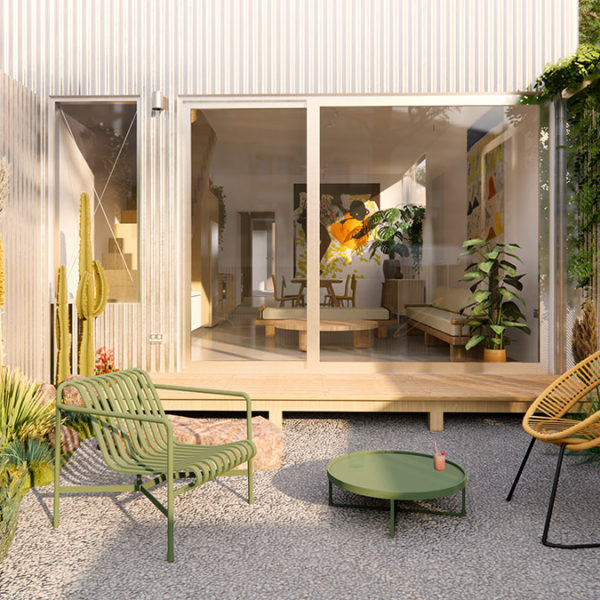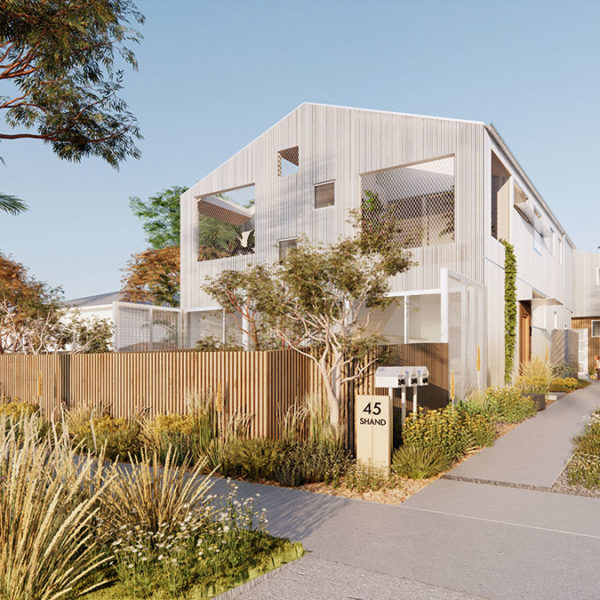45 Shand Road, Reservoir
The 45 Shand Road affordable housing development (Shand) takes an innovative approach to water sensitive urban design (WSUD) as a part of a broader approach to long-term sustainability.
Contact
Insight:
This infill development uses rainwater harvesting and raingardens to meet council flood mitigation requirements, rather than dedicated on-site ‘grey infrastructure’ like concrete pits, tanks and pipes. The project also involved a new method of assessing flood water mitigation that proves these water sensitive solutions are a viable alternative to conventional infrastructure.
The drivers
The developer, Ys Housing, is a not-for-profit organisation that aims to deliver 1,000 new, affordable homes over 10 years to combat inequality and shape a fairer, more vibrant city.
For Shand, Ys Housing set out to make sustainability more accessible and affordable. In particular, Ys Housing aimed to:
- demonstrate net-zero, water sensitive, affordable housing that is repeatable at a suburban scale
- reduce cost by replacing conventional underground concrete stormwater detention systems, with water sensitive alternatives
- meet stormwater flow volume reductions to protect waterways, as set out in EPA Victoria’s Urban Stormwater Guidance and to comply with the obligations of the General Environmental Duty in the Environment Protection Act 2017
- meet the Australian Rainfall and Runoff 2019 guideline (AR&R) for the design and modelling of flood mitigation responses
- collaborate with the City of Darebin on WSUD innovation.
The innovations
This case study uses WSUD to meet council flood mitigation requirements, rather than dedicated on-site ‘grey infrastructure’ like concrete pits, tanks and pipes.
In particular, the WSUD scheme at Shand introduced the following features:
- Household collection and reuse of rainwater – Each townhouse will be equipped with a 3000 L rainwater tank that has 2000 L for reuse and approximately 1000 L for stormwater detention. Harvested rainwater will be connected for flushing and external taps for gardens.
- Integrated swale and raingarden – The site will include a vegetated swale running the length of the driveway and a ~8 m² raingarden that runs along the front boundary, designed to support tree growth in the front set back.
- High surface permeability – The development will have ~200 m² (30%) of pervious surfaces made up of gardens, permeable paving and decking.
- Plant selection – The gardens will use native species that are local to the Victorian volcanic plains. The use of bird-attracting trees, wildflowers and scented shrubs will provide shade and encourage biodiversity, while also requiring little active irrigation because they are well adapted to the Victorian climate.
As well as using WSUD in this way, this case study also relied on a new method of assessing the flood mitigation of WSUD assets. This is a fundamental shift from the existing STORM design method. To achieve this, a new method was developed to assess on-site detention outcomes for WSUD assets that complies with AR&R.
The lessons
- Engage the council early. Council is on board with the approach, but needs advice on how to quantify the detention and retention volume contribution of raingardens, and clarity on the margin-of-safety factors to account for deterioration of the vegetated systems over time.
- Allow for additional coordination among the consulting team. The project required strong collaboration and coordination between landscape design and drainage engineering for the overall design to be successful.
- Allow for extra time, because the project is not business as usual. Novel design approaches need extra consideration and time. Often there is insufficient consulting budget in projects to allow for this extra time, especially on small projects. It can be tempting to revert back to more standard ‘grey infrastructure’ solutions to keep the project on time and on budget.
Project stats
Location
Reservoir, Victoria, Australia
Dates
2022
Project collaborators
- Ys Housing
- E2DesignLab
- Ipsum Structures
- Watkin McLennan
- Bank Australia
- City of Darebin
Contact
The outcomes
 Cities providing ecosystem services
Cities providing ecosystem services

- Stormwater quality improvements – Stormwater modelling predicts:
- 47% of the stormwater flows will be retained for reuse and evapotranspiration within the landscape (compared with a target of 28%)
- 17% of the stormwater will be infiltrated to recharge groundwater (compared with a target of 9%)
- 82% of total nitrogen will be removed from the stormwater discharge to protect Port Phillip Bay (compared with a target of 45%).
- Native vegetation – The use of native vegetation promotes increased biodiversity.
 Cities as water supply catchments
Cities as water supply catchments

- Water reuse – Rainwater harvested on the site will be used for non-drinking water use. This conserves Melbourne’s drinking water supplies.
- Water conservation – By using a drought resilient native garden, and retaining rain that falls onto the site, the garden is largely self-sufficient in its water use.
- Flood mitigation –WSUD is used to achieve flood management requirements, reducing the need for dedicated on-site detention.
 Cities comprising water sensitive communities
Cities comprising water sensitive communities

- Housing affordability – Shand delivers affordability via shared equity finance, meaning a well-located, environmentally sustainable home is available to lower income families, near jobs, schools and community.
- Health benefits – The landscaping increases urban greening with thoughtful planting design while enhancing biodiversity by incorporating native vegetation.
Interested in this solution?
We partner with small and large companies, government and industry in Australia and around the world.


Comments